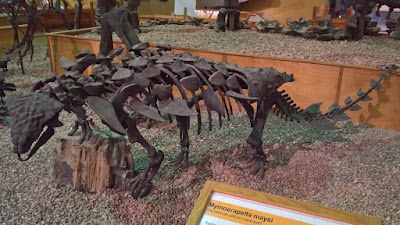Basal thyreophoran osteoderm found in the Middle Jurassic of Luxembourg
A
recent article by Delsate and colleagues (2018) describes one of the earliest thyreophoran
remains in Europe. It is an osteoderm from the lower Bajocian of Luxembourg,
found in the marls and limestone sequence of the Rumelange-Ottange Quarry, on
the Luxembourg-French border.
The
specimen exhibits features that seem to suggest a closer affinity to basal
thyreophoran, such as Scelidosaurus
for instance, than to early ankylosaurs. The smooth external surface is a plesiomorphic
condition, as well as the internal structure, which in this specimen is composed
of a thin cortical layer covering an internal lattice of trabecular bone (Scheyer
& Sander, 2004; Burns & Currie, 2014; Delsate et al., 2018). However, histological studies were not conducted and
therefore the isolated scute is at this point more definitely identified as belonging
to basal thyreoporan, although a basal ankylosaur origin is not ruled out.
A
last interesting aspect is that the osteoderm was found in a marine facies, corresponding
to an open sea environment with an oxygenated bottom, in an alternating
sequence of marls and limestones, that have provided an extensive record of marine
invertebrates and vertebrates (Delsate et
al., 2018; for further details, check references therein). This occurrence seems
to reflect the propensity for ankylosaurs (even the more basal members) to deposit
in marine environments. A recent post discusses this.
Burns, M. E., and P. J. Currie. 2014. External and internal structure of ankylosaur (Dinosauria, Ornithischia) osteoderms and their systematic relevance. Journal of Vertebrate Paleontology, 34(4): 835-851.
Scheyer, T. M., and P. M. Sander. 2004. Histology of ankylosaur osteoderms: implications for systematics and function. Journal of Vertebrate Paleontology, 24(4): 874-893.


Comments
Post a Comment